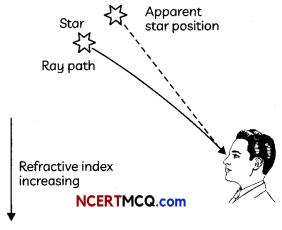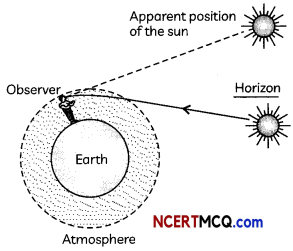Atmospheric Refraction
Atmospheric refraction is the refraction of light by the earth’s atmosphere due to the decrease of refractive index with decreasing density or increasing temperature of air.
Apparent Position of Stars
The stars appear slightly higher than its actual position when viewed near the horizon due to the phenomenon of atmospheric refraction. When the starlight enters the earth’s atmosphere, where its refractive index is increasing gradually, the starlight is bent towards the normal.

Twinkling of Stars
The apparent position of the star is not stationary, but keeps on changing slightly, since the physical conditions of the earth’s atmosphere are not stationary. Since the stars are very distant, they approximate point-sized sources of tight. As the path of rays of Light coming from the star goes on varying slightly, the apparent position of the star fluctuates and the amount of starlight entering the eye flickers – the star sometimes appears brighter, and at some other time, fainter, which is the twinkling effect.
![]()
Planets do not Twinkle
Planets are much closer to the earth and therefore act as extended sources. A planet can therefore be considered as a collection of large number of point-sized objects such that the total variation in the amount of light entering our eye from all the individual point-sized sources will average to zero, and hence the twinkling effect is nullified.

Advance sunrise and delayed sunset: The sun is visible to us 2 minutes before actual sunrise and 2 minutes after actual sunset due to atmospheric refraction.
The time difference between actual sunset and the apparent sunset is about 2 minutes. The apparent flattening of the Sun’s disc at sunrise and sunset is also due to the same phenomenon.